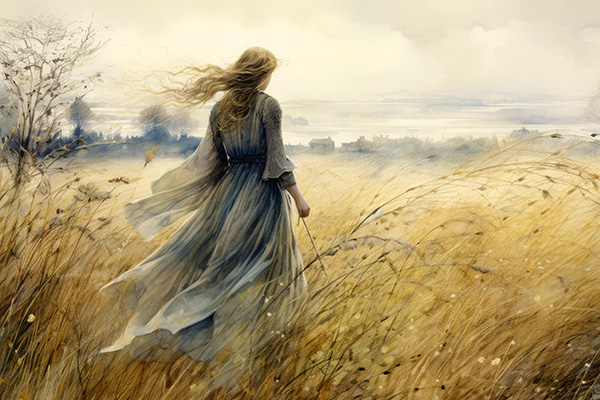folklore
The Timeless Magic Of Nature Spirits And Elementals
 As a youngster growing up in the UK, I loved visiting a neighbor, Mrs. O’Leary, whose lilting Irish voice still echoes in my mind. She spoke often of the “Good People” and acknowledged their presence in her home and garden. I recall her taking us outside to witness her making small offerings to these unseen little mystical beings.
As a youngster growing up in the UK, I loved visiting a neighbor, Mrs. O’Leary, whose lilting Irish voice still echoes in my mind. She spoke often of the “Good People” and acknowledged their presence in her home and garden. I recall her taking us outside to witness her making small offerings to these unseen little mystical beings.
Though it feels like a distant memory now, I can still recall seeing them, too. Perhaps they appeared to us because we truly believed, or perhaps because Mrs. O’Leary invited them to show themselves.
Whatever the reason, those moments left a lasting impression. To me, it felt like truly being “in my element,” fully connected to the hidden, magical forces of nature.
I vaguely recall a magical moment in Mrs. O’Leary’s garden when she pointed out to me a tiny, translucent little figure perched on a large moss-covered rock at the base of her prized old hawthorn tree. With delight, she described how this “little person” was waving at us and encouraged me to wave back. Standing there with awe and intrigue, I became aware of what seemed like hundreds of luminous sprites dancing in the glistening water below.
Despite all the cynicism of a technologically driven world, increasingly devoid of the many miracles and wonders of nature and the unseen realms, Mrs. O’Leary and the spirits of nature still remind me of the healing, transformative power that lies in reverence, stillness, and everyday magic.
The Mysteries, Messages And Magic Of Meteorites
 Meteorites have long intrigued me as one of the great mysteries of the universe. They’ve fascinated me for years, not only because they survive their fiery descent through Earth’s atmosphere in such an epic and awe-inspiring way, but also because of their extraordinary origins.
Meteorites have long intrigued me as one of the great mysteries of the universe. They’ve fascinated me for years, not only because they survive their fiery descent through Earth’s atmosphere in such an epic and awe-inspiring way, but also because of their extraordinary origins.
Recently, I acquired a small piece of meteorite from Campo del Cielo, a renowned celestial fragment discovered by Spanish explorers in Argentina in 1576. It now graces my altar with it cosmic presence, enhancing the energy of my home and sparking some fun conversations!
Their origins are diverse. Some come from asteroids or comets, others from planetary bodies.
However, what I find especially captivating about these “messengers from space” is that they offer more than just scientific insights into the birth of our solar system.
Even more compelling is the spiritual and esoteric significance they’ve held throughout human history. Across time and tradition, they continue to be revered as powerful allies in spirituality and metaphysics.
Many lithotherapy practitioners believe meteorites are gifts from the divine, reminding us of our eternal connection to the cosmos. They are symbols of spiritual awakening, transformation, and divine wisdom.
Ancient civilizations used them for meditation and healing, to connect with higher realms, and to catalyze personal growth. Because they are quite literally “otherworldly,” meteorites offer us a cosmic perspective and invite us to reflect on our place within the grand tapestry of existence.
Awakening To A New Age Of Higher Dimensions
 Many of us have been gradually becoming aware of a different kind of reality in recent years. Things that were once hidden, both good and bad, are now exposed for many of us to see.
Many of us have been gradually becoming aware of a different kind of reality in recent years. Things that were once hidden, both good and bad, are now exposed for many of us to see.
Since the new millennium began, and especially in the last ten years, more and more of us have started to feel a deeper connection to a higher power and a growing desire to align with God, Spirit, and the Divine. At the same time, we are also becoming more aware of negative and dark energies that were always present, but are now obvious and undeniable.
This worldwide change is known as the Ascension, the Shift, or the New Earth paradigm. It is a significant shift in energy and awareness. It is also known as 5D consciousness, the Age of Aquarius, or the Great Awakening.
It is a deeply personal change of moving towards unity, love, and a higher level of awareness, and away from negative, fear-based energies of a lower level of awareness.
I’ve seen enough of the negative effects of these lower vibrations in my work to know how draining and soul-destroying it can be. I plan to keep moving with the tides of this new, higher vibrational frequency, which includes not buying into the fear, drama and negativity. It also means keeping an open heart and mind.
We are living in a time of conscious evolution. We are slowly moving from the third-dimensional existence, where duality, time, and materialism remain the focus, to a fifth-dimensional reality, where love, unity, and higher consciousness.
Feeding The ‘Good Wolf’ Changes Everything!
 Since childhood, I have been fascinated by parables, folk tales and fables. I realized at a young age that there is something truly inspiring about a story that not only entertains, but carries a deeper message or spiritual lesson and speaks directly to the heart.
Since childhood, I have been fascinated by parables, folk tales and fables. I realized at a young age that there is something truly inspiring about a story that not only entertains, but carries a deeper message or spiritual lesson and speaks directly to the heart.
This love of meaningful stories hasn’t diminished over time. I still find myself drawn to stories that offer wisdom, healing, and perspective.
A few years ago, I came across a beautiful Cherokee story — one that spoke volumes to me and offers guidance to many of us as we navigate the emotional terrain of modern life.
The story goes that a young Cherokee boy found himself in a dispute with a friend. The boy felt that his friend had treated him unfairly. Hurt, and burning with anger, he stormed off to find his grandfather, a revered elder of their tribe who was known for his wisdom.
Sitting with his wise grandfather, the boy poured out his frustration, sharing the injustice he felt and the fire of anger that burned within him.
The old man listened patiently, his eyes pensve and kind. Then, with a nod, he spoke:
“I too have felt great anger at those who have taken from me what was not theirs or who have treated me unjustly. But anger wears on the soul like fire on dry grass. It consumes you if you are not careful.”
He paused, then continued, “You see, it is as if two wolves are fighting within me. One is full of anger, envy, sorrow, regret, greed, arrogance, self-pity, guilt, resentment, lies, false pride, superiority, and ego. This is the evil wolf. He lashes out, trusts no one, and isolates himself from the world.”
The Cautionary Tale Of The Lovestruck Witch
 Once upon a time, there was a goodly witch named Wanda. Though she sometimes had a fiery temper, her heart was generally in the right place.
Once upon a time, there was a goodly witch named Wanda. Though she sometimes had a fiery temper, her heart was generally in the right place.
For many years, Wanda lived a cozy life with her partner, Colwyn the Brave, in a happy and fulfilling relationship.
But one day, out of the blue, Colwyn announced that he was ending the relationship. Although he still loved Wanda, he explained that he no longer had the romantic or emotional feelings necessary to sustain the relationship.
But Wanda was no fool. Fee-fi-fo-fum, she knew by the prick of her thumb…that he was lying through his teeth! The truth was that he had decided to dump her for her so-called best friend, Suvanna the Enchantress.
Wanda was devastated. She had dedicated more than two decades of her life to this man, standing by him through thick and thin. And her friend’s betrayal only added further insult to injury.
Realizing the extent of the pain he had caused, Colwyn tried to comfort Wanda, assuring her that one day she would meet someone who would make her much happier than he ever had.
But his words fell on deaf ears. Wanda was heartbroken and very, very angry.
Then she remembered…she was a witch. She could make things happen, especially with the help of her sisterhood of witches.
Inner Journey To The Mystical Isle Of Avalon
 Sometimes when the pressures and demands of modern life become too much, I retreat to one of my favorite places in the universe: the mythical island of Avalon.
Sometimes when the pressures and demands of modern life become too much, I retreat to one of my favorite places in the universe: the mythical island of Avalon.
This legendary island of Celtic mythology is steeped in legends of healing, psychic learning, sacred crafting, and the life and times of King Arthur. Its name translates as “Isle of Apples,” emphasizing its association with fertility, abundance, and otherworldly beauty.
In folklore, Avalon, or Insula Avallonis, was a sanctuary of deep spiritual and psychic knowledge and was known as a training ground for pagan priestesses dedicated to the Great Mother Goddess. These women dedicated their lives to spirituality, honing their skills in clairvoyance, herbalism, weaving, and deep devotion to the Divine Feminine.
But Avalon was not only a sanctuary for women. Men were also an integral part of its story. Merlin the magician is inextricably linked to the history of the island, having trained the young Arthur there for his kingship.
Avalon is also entwined with many other tales woven through the lives of King Arthur, Guinevere, Morgan le Fay, Merlin, Nimue (the Lady of the Lake), and others. Legend also has it that King Arthur was brought to Avalon by his half-sister, Morgan le Fay, to heal after being badly wounded in battle.
The question of whether Avalon really existed straddles the line between myth and reality. Some historians and researchers speculate that Avalon may be based on a real place. Glastonbury, England, is often associated with Avalon because of its mystical aura and ties to Arthurian legend.
A Samhain Invitation From The Faeries
 Fairies love fun and joyful games in the great outdoors, even during the darker seasons of the year. I am reminded of this every year at this time when the veil between the worlds thins during the mystical season of Samhain and Halloween.
Fairies love fun and joyful games in the great outdoors, even during the darker seasons of the year. I am reminded of this every year at this time when the veil between the worlds thins during the mystical season of Samhain and Halloween.
If you’re currently experiencing a highly creative period or feeling called to get out into nature, even if it’s just to your garden before the weather gets too cold, there’s a good chance you’re also being invited to have some fun and free-spirited playtime with the fairies.
It is easiest for us to connect with the Faeries or Fae during the times of the year when the seasonal energy portals are open at the cross-quarter holidays of the Summer and Winter Solstices and the Spring and Fall Equinoxes.
These seasonal transitions are also traditionally celebrated in the ancient pagan festivals and religious holy days of Imbolc (St. Brigid’s Day) on February 1st, Ostara (Easter) on around March 21st, Beltane (St. Walburga’s Day) on May 1st, Litha (St. John’s Day) around June 20th or 21st, Lammas (Day of Bread) on August 1st, and Samhain (All Saints’ Day) on October 31st.
Traditionally celebrated as a time to honor our ancestors and reflect on the cycle of life and death, Samhain on October 31st marks the halfway point between the Autumnal Equinox and the Winter Solstice. It is a special time that invites us to step beyond the ordinary into the realm of magic and mysticism. The lingering echoes of autumn and the approaching winter in the Northern Hemisphere also foster a sense of introspection and connection to nature, making it an optimal time to commune with the ethereal elementals of nature.